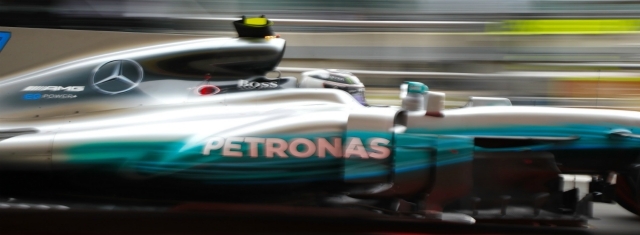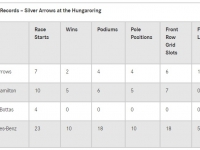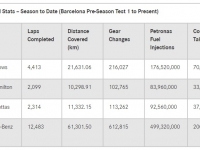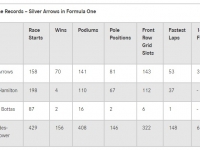Sports
2017 Hungarian Grand Prix - Preview
Hungaroring

2017 Hungarian Grand Prix - Preview (Source: © 2017 Daimler AG. All rights reserved.)
USPA NEWS -
Battle continues with Round 11 of the 2017 season from the Hungaroring
Toto Talks Hungary
Featured this Week: Keeping Your Cool
Stat Attack: Hungary and Beyond
Toto Talks Hungary
Featured this Week: Keeping Your Cool
Stat Attack: Hungary and Beyond
Toto Talks Hungary
We have reached the halfway point of the 2017 season and both championships are very much in the balance right now. The points tables show that we have a small buffer in the constructors´ race and a small deficit on the drivers´ side. But that´s not important at this stage ““ there are no prizes awarded for the half-time champions.
Our approach is to take it weekend by weekend, to build our performance at each circuit in a calm and logical way and to keep pushing. The time for worrying about the points will come later. What I see when I walk the corridors of our factories is an energy and determination like never before. It is inspiring to see how our team is tackling this championship battle.
We have reached the halfway point of the 2017 season and both championships are very much in the balance right now. The points tables show that we have a small buffer in the constructors´ race and a small deficit on the drivers´ side. But that´s not important at this stage ““ there are no prizes awarded for the half-time champions.
Our approach is to take it weekend by weekend, to build our performance at each circuit in a calm and logical way and to keep pushing. The time for worrying about the points will come later. What I see when I walk the corridors of our factories is an energy and determination like never before. It is inspiring to see how our team is tackling this championship battle.
The first half of the season was a mixed one for us. From the first test, it was clear we had a real fight on our hands with Ferrari ““ and soon we could see this might become one of the classic seasons. It was a bumpy start for us as we didn´t quite find the right set-up window to make our car function. Then we had a bad weekend in Monaco ““ like always, you learn much more from your defeats than your victories. We used that learning in the right way and, from that point, we started to turn things around.
Our drivers have been one of our biggest strengths so far. Lewis has delivered some consummate performances this year in China, Canada and Silverstone in particular. The win in front of his home crowd was emotionally charged and I am sure he is carrying that energy with him right now. As we see almost each weekend, he is equalling and matching new records in our sport´s history ““ and building a legacy as one of the sport´s greatest drivers. Budapest has always been a good circuit for him but, as he knows better than anybody else, the past is no guarantee of future performance. It´s all about the right preparation, hard work and delivering on the day.
In the other car, Valtteri has embodied Finnish resolve and fighting spirit. He has a fierce work ethic, steely approach and a great natural talent. He threw himself into the challenge of switching teams and we are now starting to see his full potential reveal itself. I have the feeling he is getting better with each passing weekend and is already a more complete driver than at the start of the season. I´m excited to imagine how he will continue to develop for the rest of the season.
So now we head to Budapest for the final race before the summer break. We enjoyed a fantastic weekend in Silverstone but it is now something nice in the history books. We have to do the job again beginning with first practice in Hungary. Our rivals will be determined to fight back strongly ““ and we have to anticipate that. There is no complacency at all at Mercedes, just a resolute determination to get the job done.
Featured This Week: Keeping Your Cool
Formula One cars are fickle beasts, built to operate at high speed and withstand G-Forces that test them to the extreme. They rank among the most advanced racing machines ever conceived. But a seemingly simple foe remains one of their biggest threats ““ heat. F1 cars have a prime temperature operating window, which they can be coaxed towards by adjusting cooling capacity to suit ambient temperatures. Slip outside of that bracket, however, and the problems begin to mount up. Fluids become critical, brakes cook and both engine and gearbox are punished.
Formula One cars are fickle beasts, built to operate at high speed and withstand G-Forces that test them to the extreme. They rank among the most advanced racing machines ever conceived. But a seemingly simple foe remains one of their biggest threats ““ heat. F1 cars have a prime temperature operating window, which they can be coaxed towards by adjusting cooling capacity to suit ambient temperatures. Slip outside of that bracket, however, and the problems begin to mount up. Fluids become critical, brakes cook and both engine and gearbox are punished.
On the surface, the solution to overheating is straightforward. Open up the bodywork and increase the mass flow of clean air in through the radiator ducts. On average, F1 cars suck in a massive five cubic metres of air through the radiators every second at 300 km/h. But that´s the first challenge of keeping a modern Grand Prix car in the right operating window, as any effort to manage cooling requires some sacrifice of aerodynamic performance. Opening up the bodywork costs around 300 milliseconds per extra 0.5 cubic metres of cooling air, as air is diverted into the radiators rather than over the rear-wing or under the car and through the diffuser. Teams must find the right balance between cooling and aerodynamic performance ““ especially with a raw performance sacrifice which can be up to a second per lap at aero-sensitive circuits.
Mapping out cooling requirements starts early in a new car´s life, with radiator design ““ both shape and size ““ all linked into chassis design. Underestimate the task here and the angle grinders will soon need to be deployed on a cold-winter morning in Barcelona, as the crew set to work opening up the car´s bodywork.
Teams run complex simulations ahead of a race weekend to prepare for the various cooling requirements presented by the 20 different circuits on the Formula One calendar. The narrow, medium speed layout of the Hungaroring, for example, requires a different level of cooling to, say, Monza with its long straights. For each level of cooling added, some aerodynamic performance will be lost, sacrificing lap time.
Teams run complex simulations ahead of a race weekend to prepare for the various cooling requirements presented by the 20 different circuits on the Formula One calendar. The narrow, medium speed layout of the Hungaroring, for example, requires a different level of cooling to, say, Monza with its long straights. For each level of cooling added, some aerodynamic performance will be lost, sacrificing lap time.
To combat overheating, teams take a war chest of parts to each race to cover any potential issues that can be created by anything as simple as a misjudged ambient temperature setting. Most cars carry a series of louvres alongside the headrest which can be swapped out to offer different levels of cooling, as well as specially shaped rear bodywork for those extra-challenging races.
When FP1 arrives, teams should already have an idea of what to expect and can offer feedback on any potential issue to the driver ““ for example, if the brakes are running hotter than expected. This is where drivers can directly make a difference, running through engine modes or lifting and coasting to manage temperatures. When a car is seen dipping out of another´s slipstream, that´s a sign of a driver struggling with a hot car or hot brakes.
When FP1 arrives, teams should already have an idea of what to expect and can offer feedback on any potential issue to the driver ““ for example, if the brakes are running hotter than expected. This is where drivers can directly make a difference, running through engine modes or lifting and coasting to manage temperatures. When a car is seen dipping out of another´s slipstream, that´s a sign of a driver struggling with a hot car or hot brakes.
Temperature management itself is an art, as teams balance cooling across key components ““ including in-car fluids, such as engine water, gearbox oil, as well as the brakes. F1 teams run brakes right to the limit ““ up to 1,200°C ““ so it´s not uncommon to hear a driver complain that his brakes are cooking. Charge air ““ the compressed air from the turbo ““ also needs to be cooled before it passes back through the engine to avoid damaging components and to maximise power output. With the introduction of KERS in 2009 (and more prominently since the advent of the Hybrid era in 2014), another factor also came into consideration ““ regulating the temperature of the ERS Energy Store.
Mexico and Hungary present arguably the greatest cooling challenges ““ but for quite different reasons. Mexico is tough because it´s situated at high altitude. The resulting lower air density ““ 783.3 millibar, at over 2,000 metres ““ means that less mass air flow passes through the car´s radiators. To combat this, the engine compressor must work harder, creating more internal heat, which in turn requires extra cooling.
Hungary presents a different challenge thanks to its high ambient temperatures ““ averaging 32°C and peaking at 35°C across the past five seasons ““ and the nature of the circuit layout. The tight, twisting track is not heavy on engine duty, but the lack of long straights ““ plus heavy traffic caused by a lack of overtaking opportunities ““ means cars struggle to find the clean air they need for cooling.
Hungary presents a different challenge thanks to its high ambient temperatures ““ averaging 32°C and peaking at 35°C across the past five seasons ““ and the nature of the circuit layout. The tight, twisting track is not heavy on engine duty, but the lack of long straights ““ plus heavy traffic caused by a lack of overtaking opportunities ““ means cars struggle to find the clean air they need for cooling.
So, what does overheating actually result in? Simply put, a loss of performance. Sochi was a prime example of this, with Valtteri able to win in clean air out front, while Lewis struggled with fluctuating temperatures behind Kimi Räikkönen´s Ferrari. What´s more, if the car is pushed too far, it will eventually grind to a halt ““ often quite spectacularly. A failure of the Control Electronics on both Silver Arrows ““ just a single lap apart ““ cost the team a 1-2 at the 2014 Canadian Grand Prix, forcing Lewis into retirement and leaving Nico to bravely nurse his car home in second.
Next stop, Hungary. With luck, the team will avoid any toasty encounters, as everybody tackles the challenge of keeping cool in the baking Budapest sunshine“¦
Stat Attack: Hungary and Beyond
Next stop, Hungary. With luck, the team will avoid any toasty encounters, as everybody tackles the challenge of keeping cool in the baking Budapest sunshine“¦
Stat Attack: Hungary and Beyond
more information: https://www.mercedesamgf1.com
2017 Hungarian Grand Prix Hungaroring Mercedes Mercedes-amg Petronas Motorsport Toto Wolff Lewis Hamilton Valtteri Bottas
Liability for this article lies with the author, who also holds the copyright. Editorial content from USPA may be quoted on other websites as long as the quote comprises no more than 5% of the entire text, is marked as such and the source is named (via hyperlink).








